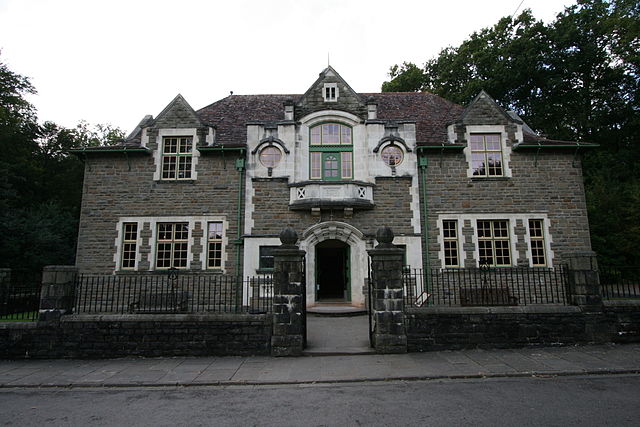Oakdale is a large village in Caerphilly county borough, Wales, 9½ miles north of Caerphilly itself, within the historic boundaries of Monmouthshire. Situated in the Sirhowy valley it is 3 miles (4.8 km) east of Blackwood, with which it forms a conurbation.
History
In the early years of the twentieth century the need for coal was growing both in America and Europe, and local business men in Wales were looking for new opportunities to fill the demand.
Among these were a group known as the Tredegar Iron and Coal Company, made up of wealthy industrialists from the Maclaren, Markham, Pochin, Whitworth and Wyllie families. They decided to create a group of collieries in the Sirhowy Valley, which explorations had told them contained rich seams of ” black gold.” One of these was at the small rural hamlet of Rhiw Syr Dafydd.
Work began clearing the site for the new colliery at Oakdale with the sinking of the pit in 1907. Waterloo shaft followed in 1911 and the building of the village commenced soon after, to house the families of the men who were to work there.
The revolutionary “model village” was the brainchild of the manager of the Tredegar Iron and Coal Company, Mr A S Tallis. This village, in contrast to others in the area, was to be built away from the mine among green fields. The houses would be modern, with hot and cold running water, large cooking ranges, electric light, and – perhaps most revolutionary of all – bathrooms. Every house was to have a front and back garden, so that no front door would open directly on to the street as in other valley towns and villages.
These ideas were in themselves original enough. But the concentric design of the village that was conceived by Mr Tallis” brother-in-law, Mr F R Webb, was even more radical. It was laid down with a central road (Central Avenue) and transverse roads conforming to a horseshoe shape, with linking “spoke” roads, making any road in the village easily accessible from any other.
The build commenced with housing, but later included schools, chapels, a hospital, a miners” institute and a cinema (the Picture House).
Opened in 1911, the colliery was owned by the Oakdale Navigation Collieries Ltd, a subsidiary of the Tredegar Iron Company. It employed a workforce of 2,235 at its peak in 1938.
In 1920 the village received a visit from Prince Albert, Duke of York (later to become King George VI) in his capacity of President of the Industrial Welfare Society. York Avenue, in the centre of the village, is so named to commemorate the visit.
Oakdale colliery was linked to Markham and the Celynen North collieries in the late 1970s and early 1980s, making it the largest colliery in Gwent. The pit closed in 1989 and the tips have now been landscaped and converted into platforms for industrial development.
The Oakdale Workmen”s Institute was considered to be such a fine example of its type that after the closure of the colliery it was demolished brick by brick, transported to, and re-erected at, St Fagans National History Museum in Cardiff.
Modern Oakdale
Oakdale Business Park, a 400-acre (1.6 km2) site on the former location of Oakdale Colliery has taken 6 years and over £10 million to reclaim, creating one of the largest plateau in the South Wales Valleys of 100 acres (0.40 km2). It has already attracted world-famous business names such as General Dynamics, which has based its European Headquarters there.
Access to the area has been made considerably easier by the construction of the Sirhowy Enterprise Way, which includes the striking, cross-valley, Chartist Bridge.
With the rapidly expanding workforce has come the need for houses and the village has seen an explosion of building in the past few years, including a new Primary school, and the former primary school at Rhiw Syr Dafydd has become a Welsh medium school called Ysgol Gymraeg Cwm Derwen.
The Oakdale and Penmaen Partnership (TOPPS), set up in 2004, is a group of voluntary members made up from the local community. It brings together representatives from the local statutory, voluntary, community and private sectors to address local problems, allocate funding, discuss strategies and initiatives. They aim to encourage joint working, and community involvement and prevent ”silo working” (i.e different agencies that share aims working in isolation) with the general aim of ensuring resources are better allocated at a local level. They also act as a middle ground between the local community and Caerphilly Council.
Discover more from LandmarkLocation.com
Subscribe to get the latest posts sent to your email.


